Analyzing Public Health Policies: Improving Food Labeling Regulations
VerifiedAdded on 2023/06/05
|8
|1781
|185
Report
AI Summary
This report provides an analysis of public health policies related to food labeling, particularly focusing on the regulation of added sugars in packaged foods and drinks. It examines the strengths and weaknesses of current draft policies, emphasizing the importance of clear and informative food labels for consumer decision-making. The report highlights the need for policies to address public health concerns such as food safety, nutrition, and the prevention of obesity and related health issues. Recommendations are made to improve the effectiveness of food labeling policies, including mandatory logic labeling of added sugars, educational campaigns, and guidelines for consumers. The report concludes that effective food labeling is a crucial tool for communication between manufacturers and consumers, and that policymakers should prioritize clear, contextual information on added sugars to promote healthier dietary choices.

1
Public Health Policy
Student’s Name
Institution
Course
Date
Public Health Policy
Student’s Name
Institution
Course
Date
Paraphrase This Document
Need a fresh take? Get an instant paraphrase of this document with our AI Paraphraser

2
Ainselie Avenue
P.O. BOX 3456,
Canberra ACT 2341
Australia.
Phone: +61 (0)2 6661 2235
24th September, 2018.
To,
Food Regulation Standing Committee (FRSC),
Rimmer Street,
P.O. BOX 5423,
Kingston ACT 2301.
RE: SUBMISSION ON THE FOOD LABELING POLICY
The consumption of food always attracts huge concern and consideration in recent few years
because of the added sugars at the time of processing and manufacturing. The Australian Dietary
guidelines and New Zealand Eating Guideline advices a very limited intake of foods which have
added sugars, fats and added salts to them. The regulatory agencies of food, tough, need all the
manufacturing labels for their foods. Labeling of food is a very significant tool of
communication within the manufacturers of food and the customers (Nelson et al. 2014, p. 590).
Due to which FRSC suggests a health policy which aims for regulating the labeling of sugars on
the drinks and also on the packaged foods due to the needs of the users in order to avail complete
knowledge about the content of food that they consume. The labeling of food also enables the
users in making the informed decisions and choices. This paper aims to analyze the policies of
Ainselie Avenue
P.O. BOX 3456,
Canberra ACT 2341
Australia.
Phone: +61 (0)2 6661 2235
24th September, 2018.
To,
Food Regulation Standing Committee (FRSC),
Rimmer Street,
P.O. BOX 5423,
Kingston ACT 2301.
RE: SUBMISSION ON THE FOOD LABELING POLICY
The consumption of food always attracts huge concern and consideration in recent few years
because of the added sugars at the time of processing and manufacturing. The Australian Dietary
guidelines and New Zealand Eating Guideline advices a very limited intake of foods which have
added sugars, fats and added salts to them. The regulatory agencies of food, tough, need all the
manufacturing labels for their foods. Labeling of food is a very significant tool of
communication within the manufacturers of food and the customers (Nelson et al. 2014, p. 590).
Due to which FRSC suggests a health policy which aims for regulating the labeling of sugars on
the drinks and also on the packaged foods due to the needs of the users in order to avail complete
knowledge about the content of food that they consume. The labeling of food also enables the
users in making the informed decisions and choices. This paper aims to analyze the policies of

3
public health which are proposed by The Food Regulation Standing Committee and
recommendations that makes sure of its efficient implementation.
Public Health Points which the Policy Needs to Address
Public health is significant due to the concerns of people about their wellbeing. Policies
are required to address public health points like safety of food and nutrition. The health report
generated in New Zealand and Australia allege that more than half of total population exceeds
the intake of added sugars (Food Standards Australia New Zealand 2017, p. 23). Hence, nutrition
is significant as it identifies the health of people. There are number of researches which displays
that the foods that contain added sugars can surely remove more nutrition in the diet of the
person and therefore it can end up resulting in the weight gain or obesity. Rather than the policy
restricting the consumption of food that contains added sugars, it can limit the amount of sugar
intakes while the food is out for manufacturing. The information about the sugar which is
provided on the labels is not at all satisfactory and it absolutely does not allow the users to take
the informed decisions in the favor of their nutritional needs (Australian Health Policy
Collaboration and the Australian Dental Association, 2018). The contamination of food and
adulteration should be appropriately addressed in the policies in order to make sure that the users
intake good food (Mhurchu and Gorton 2007, p. 109). The contamination of food and
adulteration must be aptly addresses in the policies for making sure that the consumers’ intake
food which are safe.
Similarly, regulation policy of food labeling must give the percentage of added sugars in
all the products so that the users can make their own correct decisions. Labels of food must not
only mention about the information of sodium, sugars, fats, energy etc but also mention the other
nutrients that the food provides (Dietitians Association of Australia, 2015). The policy should
public health which are proposed by The Food Regulation Standing Committee and
recommendations that makes sure of its efficient implementation.
Public Health Points which the Policy Needs to Address
Public health is significant due to the concerns of people about their wellbeing. Policies
are required to address public health points like safety of food and nutrition. The health report
generated in New Zealand and Australia allege that more than half of total population exceeds
the intake of added sugars (Food Standards Australia New Zealand 2017, p. 23). Hence, nutrition
is significant as it identifies the health of people. There are number of researches which displays
that the foods that contain added sugars can surely remove more nutrition in the diet of the
person and therefore it can end up resulting in the weight gain or obesity. Rather than the policy
restricting the consumption of food that contains added sugars, it can limit the amount of sugar
intakes while the food is out for manufacturing. The information about the sugar which is
provided on the labels is not at all satisfactory and it absolutely does not allow the users to take
the informed decisions in the favor of their nutritional needs (Australian Health Policy
Collaboration and the Australian Dental Association, 2018). The contamination of food and
adulteration should be appropriately addressed in the policies in order to make sure that the users
intake good food (Mhurchu and Gorton 2007, p. 109). The contamination of food and
adulteration must be aptly addresses in the policies for making sure that the consumers’ intake
food which are safe.
Similarly, regulation policy of food labeling must give the percentage of added sugars in
all the products so that the users can make their own correct decisions. Labels of food must not
only mention about the information of sodium, sugars, fats, energy etc but also mention the other
nutrients that the food provides (Dietitians Association of Australia, 2015). The policy should
⊘ This is a preview!⊘
Do you want full access?
Subscribe today to unlock all pages.

Trusted by 1+ million students worldwide
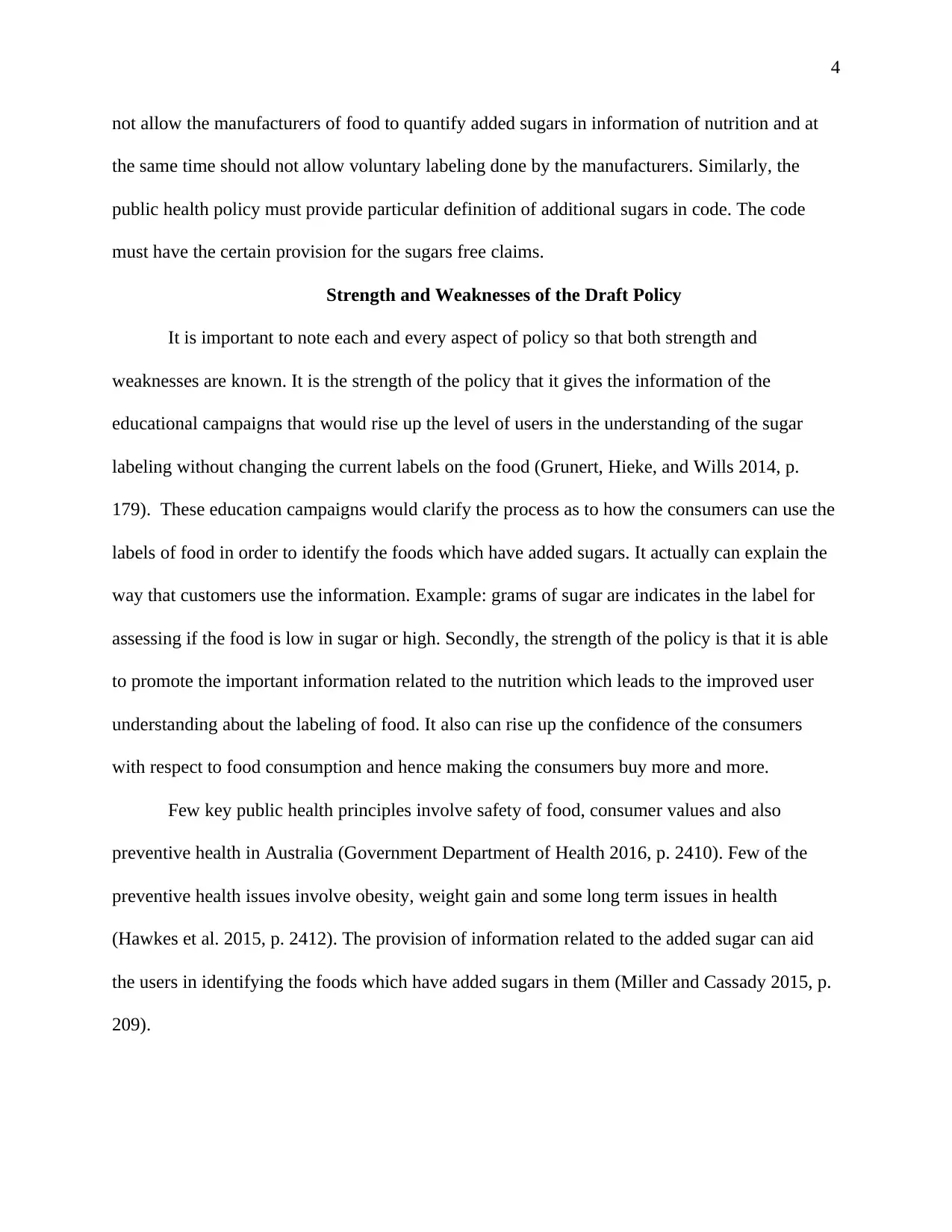
4
not allow the manufacturers of food to quantify added sugars in information of nutrition and at
the same time should not allow voluntary labeling done by the manufacturers. Similarly, the
public health policy must provide particular definition of additional sugars in code. The code
must have the certain provision for the sugars free claims.
Strength and Weaknesses of the Draft Policy
It is important to note each and every aspect of policy so that both strength and
weaknesses are known. It is the strength of the policy that it gives the information of the
educational campaigns that would rise up the level of users in the understanding of the sugar
labeling without changing the current labels on the food (Grunert, Hieke, and Wills 2014, p.
179). These education campaigns would clarify the process as to how the consumers can use the
labels of food in order to identify the foods which have added sugars. It actually can explain the
way that customers use the information. Example: grams of sugar are indicates in the label for
assessing if the food is low in sugar or high. Secondly, the strength of the policy is that it is able
to promote the important information related to the nutrition which leads to the improved user
understanding about the labeling of food. It also can rise up the confidence of the consumers
with respect to food consumption and hence making the consumers buy more and more.
Few key public health principles involve safety of food, consumer values and also
preventive health in Australia (Government Department of Health 2016, p. 2410). Few of the
preventive health issues involve obesity, weight gain and some long term issues in health
(Hawkes et al. 2015, p. 2412). The provision of information related to the added sugar can aid
the users in identifying the foods which have added sugars in them (Miller and Cassady 2015, p.
209).
not allow the manufacturers of food to quantify added sugars in information of nutrition and at
the same time should not allow voluntary labeling done by the manufacturers. Similarly, the
public health policy must provide particular definition of additional sugars in code. The code
must have the certain provision for the sugars free claims.
Strength and Weaknesses of the Draft Policy
It is important to note each and every aspect of policy so that both strength and
weaknesses are known. It is the strength of the policy that it gives the information of the
educational campaigns that would rise up the level of users in the understanding of the sugar
labeling without changing the current labels on the food (Grunert, Hieke, and Wills 2014, p.
179). These education campaigns would clarify the process as to how the consumers can use the
labels of food in order to identify the foods which have added sugars. It actually can explain the
way that customers use the information. Example: grams of sugar are indicates in the label for
assessing if the food is low in sugar or high. Secondly, the strength of the policy is that it is able
to promote the important information related to the nutrition which leads to the improved user
understanding about the labeling of food. It also can rise up the confidence of the consumers
with respect to food consumption and hence making the consumers buy more and more.
Few key public health principles involve safety of food, consumer values and also
preventive health in Australia (Government Department of Health 2016, p. 2410). Few of the
preventive health issues involve obesity, weight gain and some long term issues in health
(Hawkes et al. 2015, p. 2412). The provision of information related to the added sugar can aid
the users in identifying the foods which have added sugars in them (Miller and Cassady 2015, p.
209).
Paraphrase This Document
Need a fresh take? Get an instant paraphrase of this document with our AI Paraphraser
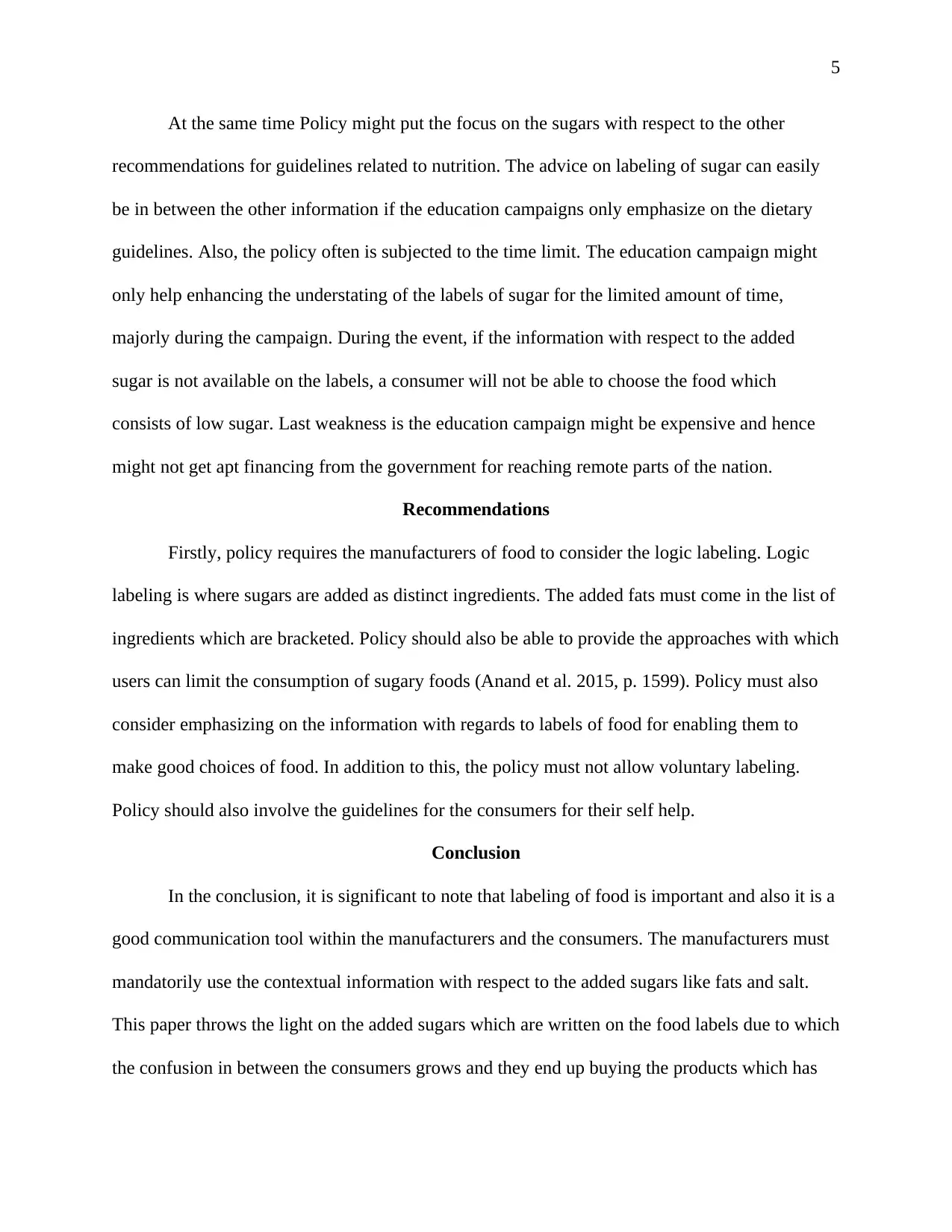
5
At the same time Policy might put the focus on the sugars with respect to the other
recommendations for guidelines related to nutrition. The advice on labeling of sugar can easily
be in between the other information if the education campaigns only emphasize on the dietary
guidelines. Also, the policy often is subjected to the time limit. The education campaign might
only help enhancing the understating of the labels of sugar for the limited amount of time,
majorly during the campaign. During the event, if the information with respect to the added
sugar is not available on the labels, a consumer will not be able to choose the food which
consists of low sugar. Last weakness is the education campaign might be expensive and hence
might not get apt financing from the government for reaching remote parts of the nation.
Recommendations
Firstly, policy requires the manufacturers of food to consider the logic labeling. Logic
labeling is where sugars are added as distinct ingredients. The added fats must come in the list of
ingredients which are bracketed. Policy should also be able to provide the approaches with which
users can limit the consumption of sugary foods (Anand et al. 2015, p. 1599). Policy must also
consider emphasizing on the information with regards to labels of food for enabling them to
make good choices of food. In addition to this, the policy must not allow voluntary labeling.
Policy should also involve the guidelines for the consumers for their self help.
Conclusion
In the conclusion, it is significant to note that labeling of food is important and also it is a
good communication tool within the manufacturers and the consumers. The manufacturers must
mandatorily use the contextual information with respect to the added sugars like fats and salt.
This paper throws the light on the added sugars which are written on the food labels due to which
the confusion in between the consumers grows and they end up buying the products which has
At the same time Policy might put the focus on the sugars with respect to the other
recommendations for guidelines related to nutrition. The advice on labeling of sugar can easily
be in between the other information if the education campaigns only emphasize on the dietary
guidelines. Also, the policy often is subjected to the time limit. The education campaign might
only help enhancing the understating of the labels of sugar for the limited amount of time,
majorly during the campaign. During the event, if the information with respect to the added
sugar is not available on the labels, a consumer will not be able to choose the food which
consists of low sugar. Last weakness is the education campaign might be expensive and hence
might not get apt financing from the government for reaching remote parts of the nation.
Recommendations
Firstly, policy requires the manufacturers of food to consider the logic labeling. Logic
labeling is where sugars are added as distinct ingredients. The added fats must come in the list of
ingredients which are bracketed. Policy should also be able to provide the approaches with which
users can limit the consumption of sugary foods (Anand et al. 2015, p. 1599). Policy must also
consider emphasizing on the information with regards to labels of food for enabling them to
make good choices of food. In addition to this, the policy must not allow voluntary labeling.
Policy should also involve the guidelines for the consumers for their self help.
Conclusion
In the conclusion, it is significant to note that labeling of food is important and also it is a
good communication tool within the manufacturers and the consumers. The manufacturers must
mandatorily use the contextual information with respect to the added sugars like fats and salt.
This paper throws the light on the added sugars which are written on the food labels due to which
the confusion in between the consumers grows and they end up buying the products which has
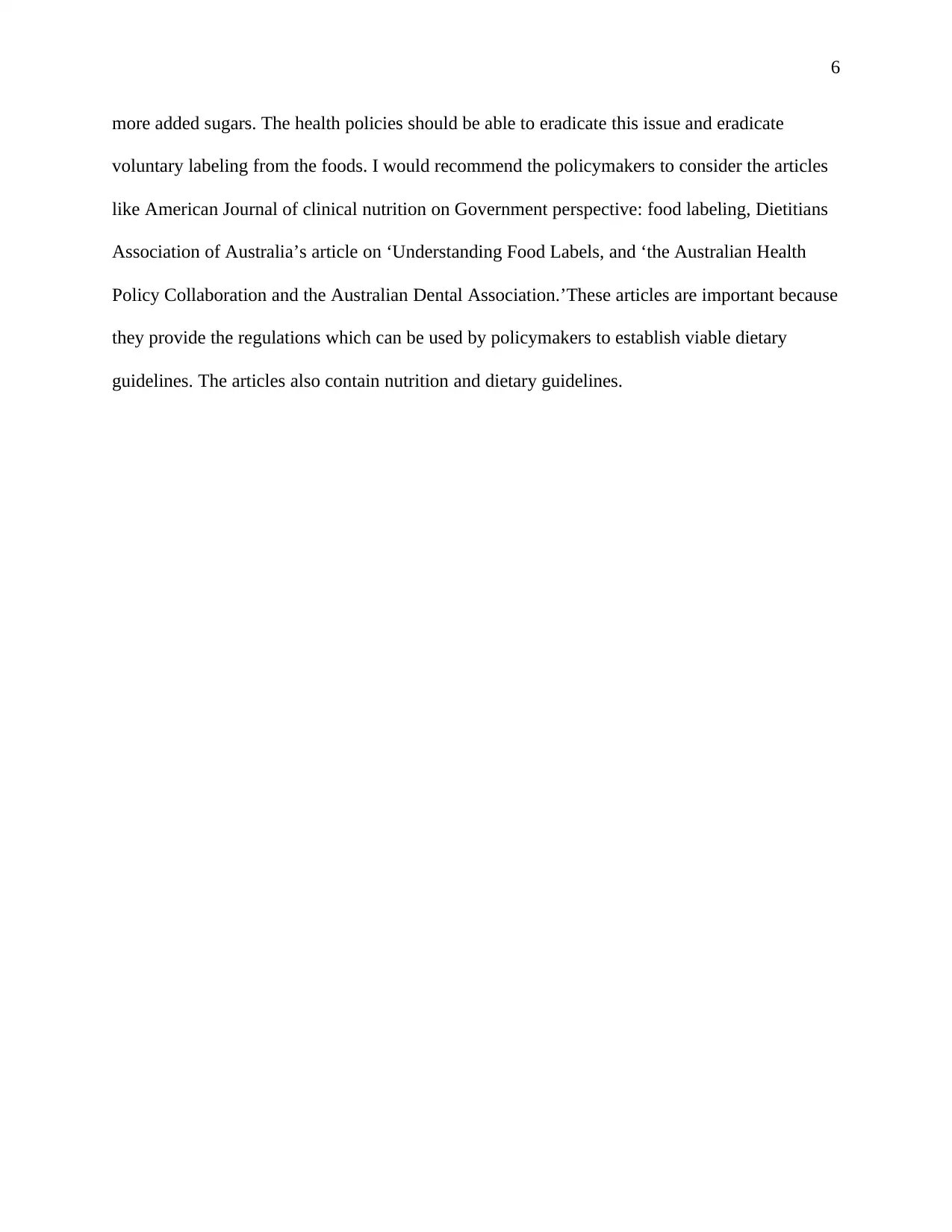
6
more added sugars. The health policies should be able to eradicate this issue and eradicate
voluntary labeling from the foods. I would recommend the policymakers to consider the articles
like American Journal of clinical nutrition on Government perspective: food labeling, Dietitians
Association of Australia’s article on ‘Understanding Food Labels, and ‘the Australian Health
Policy Collaboration and the Australian Dental Association.’These articles are important because
they provide the regulations which can be used by policymakers to establish viable dietary
guidelines. The articles also contain nutrition and dietary guidelines.
more added sugars. The health policies should be able to eradicate this issue and eradicate
voluntary labeling from the foods. I would recommend the policymakers to consider the articles
like American Journal of clinical nutrition on Government perspective: food labeling, Dietitians
Association of Australia’s article on ‘Understanding Food Labels, and ‘the Australian Health
Policy Collaboration and the Australian Dental Association.’These articles are important because
they provide the regulations which can be used by policymakers to establish viable dietary
guidelines. The articles also contain nutrition and dietary guidelines.
⊘ This is a preview!⊘
Do you want full access?
Subscribe today to unlock all pages.

Trusted by 1+ million students worldwide
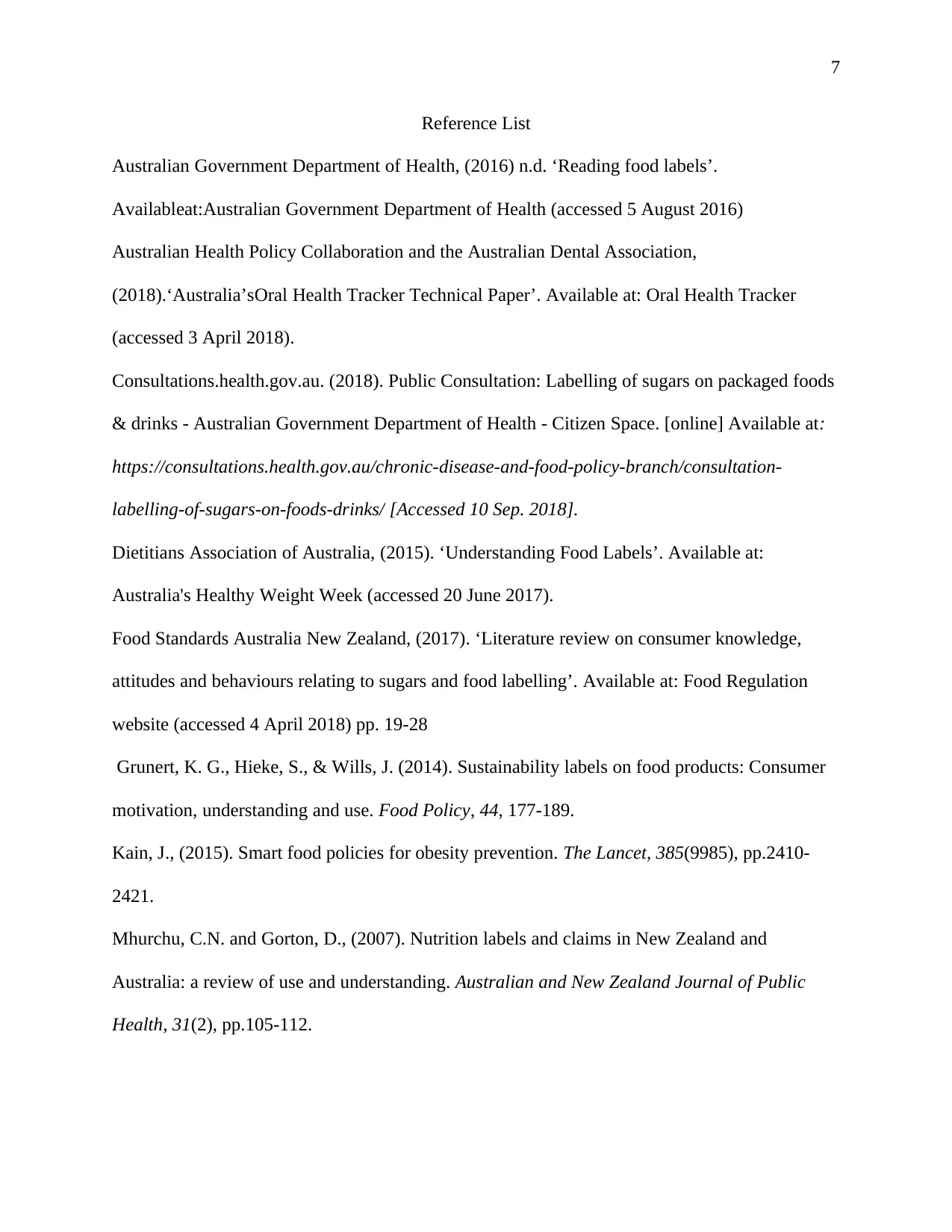
7
Reference List
Australian Government Department of Health, (2016) n.d. ‘Reading food labels’.
Availableat:Australian Government Department of Health (accessed 5 August 2016)
Australian Health Policy Collaboration and the Australian Dental Association,
(2018).‘Australia’sOral Health Tracker Technical Paper’. Available at: Oral Health Tracker
(accessed 3 April 2018).
Consultations.health.gov.au. (2018). Public Consultation: Labelling of sugars on packaged foods
& drinks - Australian Government Department of Health - Citizen Space. [online] Available at:
https://consultations.health.gov.au/chronic-disease-and-food-policy-branch/consultation-
labelling-of-sugars-on-foods-drinks/ [Accessed 10 Sep. 2018].
Dietitians Association of Australia, (2015). ‘Understanding Food Labels’. Available at:
Australia's Healthy Weight Week (accessed 20 June 2017).
Food Standards Australia New Zealand, (2017). ‘Literature review on consumer knowledge,
attitudes and behaviours relating to sugars and food labelling’. Available at: Food Regulation
website (accessed 4 April 2018) pp. 19-28
Grunert, K. G., Hieke, S., & Wills, J. (2014). Sustainability labels on food products: Consumer
motivation, understanding and use. Food Policy, 44, 177-189.
Kain, J., (2015). Smart food policies for obesity prevention. The Lancet, 385(9985), pp.2410-
2421.
Mhurchu, C.N. and Gorton, D., (2007). Nutrition labels and claims in New Zealand and
Australia: a review of use and understanding. Australian and New Zealand Journal of Public
Health, 31(2), pp.105-112.
Reference List
Australian Government Department of Health, (2016) n.d. ‘Reading food labels’.
Availableat:Australian Government Department of Health (accessed 5 August 2016)
Australian Health Policy Collaboration and the Australian Dental Association,
(2018).‘Australia’sOral Health Tracker Technical Paper’. Available at: Oral Health Tracker
(accessed 3 April 2018).
Consultations.health.gov.au. (2018). Public Consultation: Labelling of sugars on packaged foods
& drinks - Australian Government Department of Health - Citizen Space. [online] Available at:
https://consultations.health.gov.au/chronic-disease-and-food-policy-branch/consultation-
labelling-of-sugars-on-foods-drinks/ [Accessed 10 Sep. 2018].
Dietitians Association of Australia, (2015). ‘Understanding Food Labels’. Available at:
Australia's Healthy Weight Week (accessed 20 June 2017).
Food Standards Australia New Zealand, (2017). ‘Literature review on consumer knowledge,
attitudes and behaviours relating to sugars and food labelling’. Available at: Food Regulation
website (accessed 4 April 2018) pp. 19-28
Grunert, K. G., Hieke, S., & Wills, J. (2014). Sustainability labels on food products: Consumer
motivation, understanding and use. Food Policy, 44, 177-189.
Kain, J., (2015). Smart food policies for obesity prevention. The Lancet, 385(9985), pp.2410-
2421.
Mhurchu, C.N. and Gorton, D., (2007). Nutrition labels and claims in New Zealand and
Australia: a review of use and understanding. Australian and New Zealand Journal of Public
Health, 31(2), pp.105-112.
Paraphrase This Document
Need a fresh take? Get an instant paraphrase of this document with our AI Paraphraser
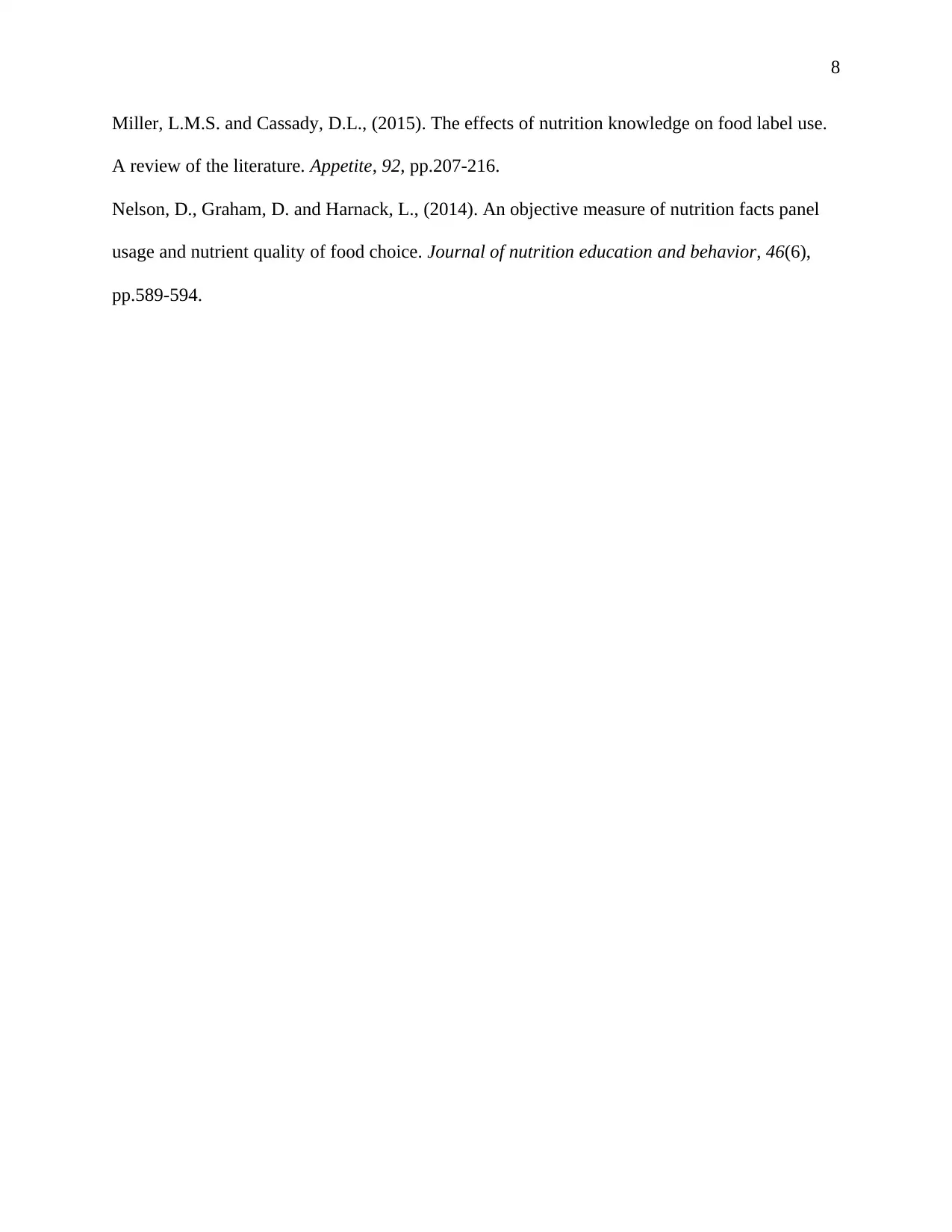
8
Miller, L.M.S. and Cassady, D.L., (2015). The effects of nutrition knowledge on food label use.
A review of the literature. Appetite, 92, pp.207-216.
Nelson, D., Graham, D. and Harnack, L., (2014). An objective measure of nutrition facts panel
usage and nutrient quality of food choice. Journal of nutrition education and behavior, 46(6),
pp.589-594.
Miller, L.M.S. and Cassady, D.L., (2015). The effects of nutrition knowledge on food label use.
A review of the literature. Appetite, 92, pp.207-216.
Nelson, D., Graham, D. and Harnack, L., (2014). An objective measure of nutrition facts panel
usage and nutrient quality of food choice. Journal of nutrition education and behavior, 46(6),
pp.589-594.
1 out of 8
Related Documents
Your All-in-One AI-Powered Toolkit for Academic Success.
+13062052269
info@desklib.com
Available 24*7 on WhatsApp / Email
![[object Object]](/_next/static/media/star-bottom.7253800d.svg)
Unlock your academic potential
Copyright © 2020–2026 A2Z Services. All Rights Reserved. Developed and managed by ZUCOL.





